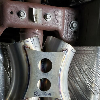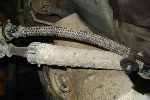RhinoQuartz
Well-Known Member
- Joined
- December 16, 2018
- Messages
- 689
- Reaction score
- 118
- Year, Model & Trim Level
- 17 Explorer Base
Hmm, not sure if vent holes are standard, one would assume so, but that's a dangerous game to play here lol.I stand corrected, thank you, was not sure all years held same amount. Given that unit has a "vent tube" is it really possible to overfill? I mean all it might do is burp out a little and be a bit of a mess. Thoughts??
From what I've seen on this forum and others, there's only about 8oz from factory and that seems to be standard, which seems like quite the oversight for it to have gone on for close to a decade of production, on top of the fact that they continuously redesigned the PTU throughout the generation. Makes me think they had a good reason to underfill
In any case, filling it up full might be fine, or it might put pressure on the seal to weaken, can't say for certain.
Personally I think a drain and refill every 30k miles with at least 12oz of fluid would easily increase its longevity.











